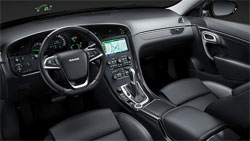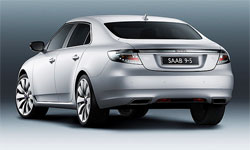2011 Saab 9-5
It’s true that Saab lost a lot of its quirkiness under GM ownership, but it also became a much more reliable car, and we would argue, better looking as well. The nearly 7-inch longer 9-5 wears styling that is certainly smoother and more elegant than Saabs of yore.
The front end is very smooth, with available Bi-Xenon cornering headlights that have an upscale bluish tint. Attractive, optional 18-inch alloys highlight a profile with a hockey-stick character line that points to a thick C-pillar and high deck lid. And, full width LED taillights help to set off an otherwise stoic rear end.
Saab’s have always had a fun to drive nature that few other front wheel drive cars could match, and while that nature didn’t fully hold up on a track, it was more than acceptable for back roads blasting. Still, when blasting through the cones at our track, the new 9-5 with its GM Epsilon chassis held up very well. Steering is light, precise, and just about perfect; by far the best part of the car. The new 9-5 may look far more luxury than sport, but handling performance was more aggressive than we were expecting.
For power, the 9-5 sports either a 2.8-liter V6, or our cars more traditional, turbocharged 2.0-liter I4. Output is 220-horsepower with an even healthier 258 lb. feet of torque. A 6-speed manual came standard in our Turbo4, with a 6-speed automatic optional. The automatic is standard with the V-6. Unfortunately, traditional Saab power is only adequate for this nearly two-ton 9-5. With only modest boost available, it took all of 8.2-seconds to reach 60, and 16.3 seconds to make it to the end of the quarter mile at a decent 91 miles per hour. Our car’s 6-speed manual proved very smooth, however.
 But, what is the 9-5 like to actually live with. Well, the interior will be familiar to current Saab owners. A very driver oriented, aircraft inspired layout, with clear gauges and ergonomically correct switchgear. But, while all quite traditional, it also seems quite dated. Yes, a cool center console start button has replaced the key, but everything else seems yesterday. Including some of the worst looking fake wood we’ve seen in years. On the plus side, all seats are very comfortable and supportive, including those in the rear, where you’ll also find increased leg room. And the huge trunk, another Saab tradition, is almost wagon-like in its usefulness, especially when you add the optional U-Rail cargo system.
But, what is the 9-5 like to actually live with. Well, the interior will be familiar to current Saab owners. A very driver oriented, aircraft inspired layout, with clear gauges and ergonomically correct switchgear. But, while all quite traditional, it also seems quite dated. Yes, a cool center console start button has replaced the key, but everything else seems yesterday. Including some of the worst looking fake wood we’ve seen in years. On the plus side, all seats are very comfortable and supportive, including those in the rear, where you’ll also find increased leg room. And the huge trunk, another Saab tradition, is almost wagon-like in its usefulness, especially when you add the optional U-Rail cargo system.
In suburban use, we found all of the elements of the 9-5 jelled very well. The new 9-5 reacts to uneven road conditions with grace and overall is pleasantly refined. Soundproofing is excellent, providing 9-5 occupants a comforting, luxury car experience, while retaining a people and cargo versatility that no rival sedan can match. Government Fuel Economy Ratings for our manually equipped Turbo4 are 20-City and 33-Highway. Expect 25 in daily driving using affordable Regular grade gas. The Energy Impact Score is a better than average 13.7 barrels of oil consumed per year, with a carbon footprint of 7.5 annual tons of CO2 emitted.
 The 2011 Saab 9-5 is a little hard to classify. It handles like a true sport sedan, has an interior that’s behind the times, and a price tag that’s definitely luxury car; starting at $39,350. Stepping up to V6 power and all-wheel-drive will take you over 50-grand. You can tell we were perplexed by the 2011 Saab 9-5. It’s a huge improvement over the former car; better looking, better handling, and far more accommodating. But, maybe it holds onto tradition a little too much, and there are too many off-the-shelf GM parts for true prestige status. Still, Saab fans will like it, and most short comings can be easily addressed. We just hope this Saab story still has a chance for a happy ending.
The 2011 Saab 9-5 is a little hard to classify. It handles like a true sport sedan, has an interior that’s behind the times, and a price tag that’s definitely luxury car; starting at $39,350. Stepping up to V6 power and all-wheel-drive will take you over 50-grand. You can tell we were perplexed by the 2011 Saab 9-5. It’s a huge improvement over the former car; better looking, better handling, and far more accommodating. But, maybe it holds onto tradition a little too much, and there are too many off-the-shelf GM parts for true prestige status. Still, Saab fans will like it, and most short comings can be easily addressed. We just hope this Saab story still has a chance for a happy ending.
Specifications
- Engine: 2.0-liter I4
- Horsepower: 220
- Torque: 258 lb-feet
- 0-60 mph: 8.2 seconds
- 1/4 mile: 16.3 seconds @ 91mph
- EPA: 20 mpg city/ 33 mpg highway.
- Energy Impact: 13.7 barrels oil/yr
- CO2 Emissions: 7.5 tons/yr






